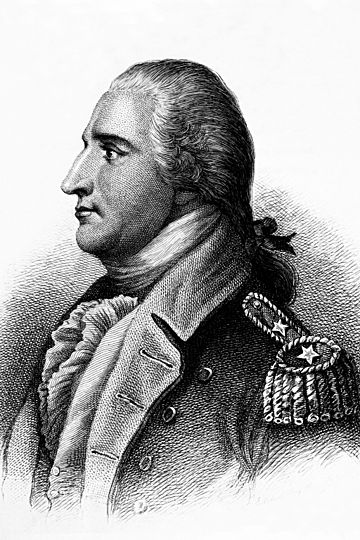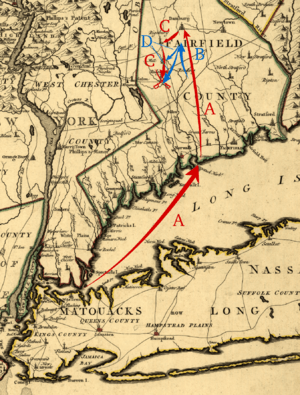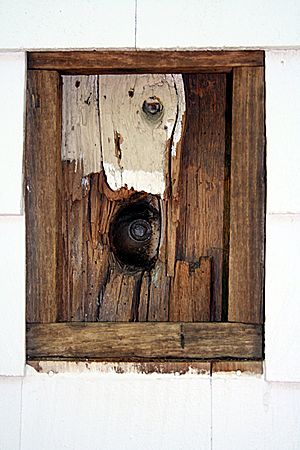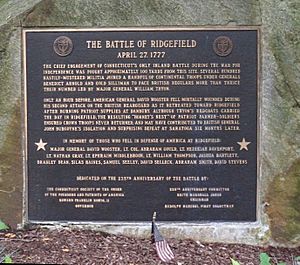Battle of Ridgefield facts for kids
Quick facts for kids Battle of Ridgefield |
|||||||
|---|---|---|---|---|---|---|---|
| Part of the American Revolutionary War | |||||||
 Monument to David Wooster in Danbury, Connecticut |
|||||||
|
|||||||
| Belligerents | |||||||
| Commanders and leaders | |||||||
| David Wooster † Gold S. Silliman Benedict Arnold John Lamb Jedediah Huntington Henry Ludington Joseph Platt Cooke |
William Tryon William Erskine James Agnew Henry Duncan |
||||||
| Strength | |||||||
| 700 (Ridgefield) 1,000 (landing skirmish) |
1,800 6 guns |
||||||
| Casualties and losses | |||||||
| 20 killed 40–80 wounded |
104–154 killed and wounded 40 captured |
||||||
The Battle of Ridgefield was a battle and a series of skirmishes between American and British forces during the American Revolutionary War. The main battle was fought in the village of Ridgefield, Connecticut, on April 27, 1777. More skirmishing occurred the next day between Ridgefield and the coastline near Westport, Connecticut.
On April 25, 1777, a British force landed between Fairfield and Norwalk (now Westport) under the command of New York's Royal Governor Major General William Tryon. They marched to Danbury, where they destroyed Continental Army supplies after chasing off a small garrison of troops. Word spread concerning the British troop movements, and Connecticut militia leaders sprang into action. Major General David Wooster, Brigadier General Gold Selleck Silliman, and Brigadier General Benedict Arnold raised a combined force of roughly 700 Continental Army regular and irregular local militia forces to oppose the raiders, but they could not reach Danbury in time to prevent the destruction of the supplies. Instead, they set out to harass the British on their return to the coast.
The company led by General Wooster twice attacked Tryon's rear guard during their march south on April 27. Wooster was mortally wounded in the second encounter, and he died five days later. The main encounter then took place at Ridgefield, where several hundred militia under Arnold's command confronted the British; they were driven away in a running battle down the town's main street, but not before inflicting casualties on the British. Additional militia forces arrived, and the next day they continued to harass the British as they returned to Compo Point on the beach in Westport where the fleet awaited them. Arnold regrouped the militia and some artillery to make a stand against the British near their landing site, but his position was flanked and his force scattered by artillery fire and a bayonet charge.
The expedition was a tactical success for the British forces, but the raid galvanized Patriot support in Connecticut.
Contents
Background
The state of Connecticut was not a scene of conflict during the first two years of the American Revolutionary War, even though the war had begun in neighboring Massachusetts in April 1775, and New York City had been taken by the British in the New York and New Jersey campaign in the fall of 1776. Major General William Howe commanded the British forces in New York, and he drafted a plan for 1777 in which the primary goal was to take the American capital at Philadelphia. Troops left to defend New York were to include a brigade of 3,000 provincial troops under the command of New York's former royal governor William Tryon, who was given a temporary promotion to "major general of the provincials" in spring 1777. Howe's plan included authorizing Tryon to operate on the Hudson River or to "enter Connecticut as circumstances may point out." Tryon was given one of the early operations of the season, a raid against a Continental Army depot at Danbury, Connecticut. Howe had learned of the depot's existence through a spy working for British Indian agent Guy Johnson, and he had also met with some success in an earlier raid against the Continental Army outpost at Peekskill, New York.
A fleet was assembled consisting of 12 transports, a hospital ship, and some small craft, all under the command of Captain Henry Duncan. The landing force consisted of 1,500 regulars drawn from the 4th, 15th, 23rd, 27th, 44th, and 64th regiments, 300 Loyalists from the Prince of Wales American Regiment led by Montfort Browne, and a small contingent of the 17th Light Dragoons, all led by Generals Sir William Erskine and James Agnew. Command of the entire operation was given to General Tryon, and the fleet sailed from New York on April 22, 1777.
The Danbury depot had been established in 1776 by order of the Second Continental Congress, and it primarily served forces located in the Hudson River valley. In April 1777, the army began mustering regiments for that year's campaigns, and there were about 50 Continental Army soldiers and 100 local militia at Danbury under the command of Joseph Platt Cooke, a local resident and a colonel in the state militia.
Danbury
Commodore Duncan anchored his fleet on April 25 at the mouth of the Saugatuck River and landed Tryon's troops on the eastern shore at a place called Compo Point in Westport, Connecticut, which was still part of Fairfield at the time. They moved inland about 8 miles (13 km) and camped in Weston, and they reached Danbury early the next afternoon. All along the march, militia fired on them, attempting to slow their advance. They drove off Cooke's troops, who had been attempting to remove supplies, killing at least three and capturing at least two in skirmishes. Before their departure early the next morning, the British destroyed 4,000 to 5,000 barrels of pork, beef, and flour, 5,000 pairs of shoes, 2,000 bushels of grain, and 1,600 tents, among other supplies; the troops also consumed significant quantities of rum. The tory houses had marks on their chimneys to avoid the torch.
The British fleet was first spotted when it passed Norwalk, Connecticut. When the troops landed, Patriot messengers were dispatched to warn Danbury and local militia leaders of the movements. Major General David Wooster and Brigadier General Benedict Arnold were in New Haven when messengers reached them on April 26, and Wooster immediately sent the local militia to Fairfield. When he and Arnold reached Fairfield, they learned that General Silliman, the commander of the Fairfield County militia, had already departed for Redding with orders that any militia raised should follow as rapidly as possible. Wooster and Arnold immediately moved in that direction. Silliman assembled a force numbering about 500 militia members and 100 Continental Army regulars. The alarm was broadcast as far as Peekskill, where Alexander McDougall began mobilizing Continental Army troops garrisoned there to intercept Tryon in case he entered Westchester County, New York. The force then moved out, heading toward Danbury in a pouring rain. By 11 pm, they had only reached Bethel, Connecticut, about 2 miles (3 km) short of Danbury. Their gunpowder was wet, making battle impossible, so they spent the night there rather than pressing on to Danbury.
Ridgefield

Tryon was alerted to the presence of the Americans in Bethel around 1 am on April 27, cutting short thoughts of remaining for another day in Danbury. Rousing the troops, he ordered the houses of Patriots to be burned; in all, more than twenty structures were destroyed. The troops then left Danbury around dawn, and marched south toward the village of Ridgefield in an attempt to avoid General Wooster's force. Hoping to delay General Tryon until overwhelming reinforcements arrived, General Wooster split his force. The main body, about 400 men, went with Generals Arnold and Silliman across the countryside to Ridgefield, where they were met by another 100 militiamen, and erected crude barricades on the road through town. General Wooster personally chased after the British column with the remaining 200; his effort was assisted by local Patriots who created impediments before the British column, including the destruction of at least one bridge. Taking advantage of the element of surprise, Wooster engaged Tryon's rear guard as it paused for breakfast about 3 miles (4.8 km) north of the town of Ridgefield, killing at least two British soldiers. Wooster took about forty prisoners in this first engagement, and then retreated for cover in nearby woods. He struck again an hour later, but the British were more prepared for a second engagement, having positioned three artillery pieces with their rear guard, spraying the colonials with grape shot. Rallying his men, the 67-year-old General Wooster was mortally wounded moments after yelling "Come on my boys! Never mind such random shots!" about 2 miles (3.2 km) from Ridgefield's town center; his inexperienced militia dissolved in confusion. Wooster died five days later in Danbury at the home of Nehemiah Dibble, whose house had also served as General Tryon's temporary quarters in Danbury. Wooster's last words were reported to be "I am dying, but with a strong hope and persuasion that my country will gain her independence." Wooster's harassment of the British column had provided enough time for Arnold and Silliman to prepare a crude defensive position at Ridgefield.
The British column arrived at the base of Arnold's barricade at the northern end of Ridgefield's town center sometime after noon. Following an hour-long artillery barrage of the barricade, Tryon dispatched flanking parties to test both sides of the American position. Having anticipated this move, General Silliman posted forces at both flanks that blunted initial thrusts. Outnumbering the Patriot forces by more than three to one, Tryon chose to advance on all three fronts including a 600-man column under covering artillery fire against the barricade itself under the leadership of General Erskine. Tryon directed General Agnew to send out flankers, whose enfilading fire helped breach the barricade. The British then pursued the Patriot forces in a running battle the length of Town Street, and gained control of the town. With 12 dead and 24 wounded, the Americans withdrew under General Arnold's orders. After the barricade was breached, Arnold was positioned between his men and an advancing enemy platoon when his horse was struck by nine musket shots. The horse went down, and Arnold was pinned and tangled in its trappings. A British soldier charged him shouting for Arnold to surrender. Arnold shouted "Not Yet" and shot and killed the soldier. He then ran off with his troops with a slightly injured leg. This entire engagement took around fifteen minutes.
British return to the fleet
After encamping for the night just south of Ridgefield, the British forces departed the next morning, leaving six houses and the Episcopal church (a Patriot supply depot and field hospital) in flames. During the night, the militia had regrouped under the command of Continental Army Colonel Jedediah Huntington, and were expanded to about 500 men by the arrival of more militia from Connecticut, as well as a militia force from neighboring Dutchess County, New York led by Colonel Henry Ludington. This force engaged in a swarming harassment of the British column as it moved south that resembled the British retreat from Concord at the start of the war. From behind convenient stone walls, trees, and buildings the militia constantly fired at the British column as it headed back toward Compo Beach.
In the meantime, General Arnold had gathered about 500 reinforcements further south, including a small company of Continental artillery led by Colonel John Lamb. Arnold adopted a strong position on Compo Hill that commanded the roads leading across the Saugatuck River toward the beach, and waited for the British to arrive. Tryon's force forded the Saugatuck River well above Arnold's position. This prompted Arnold and the chasing militia, now led by General Silliman, to attempt an entrapment of the British before they reached the beach. However, the British column, moving at full speed, was able to gain the high ground, and was joined by some fresh marines landed from the ships to provide cover for the embarkation. Arnold then prepared his force to attack the British, but a well-timed bayonet charge by Erskine's men broke the formation in spite of determined action by Lamb's artillery and Arnold's attempts to rally the troops. During the skirmish, Arnold had a second horse shot out under him, and Lamb was injured. The British successfully embarked and sailed for New York.
The official British report listed 26 killed, 117 wounded, and 29 missing. The Pennsylvania Journal reported on May 14, 1777 that the British casualties were 14 enlisted men killed, with 10 officers and 80 enlisted men wounded. The New York Gazette of May 19, 1777 published a Patriot account stating that 40 British prisoners were taken by the Americans. Douglas Southall Freeman gave the British loss as 154 killed and wounded.
The Americans were reported to lose about 20 killed, with between 40 and 80 wounded, although the British claimed in their reports that more than 100 Americans were killed, and over 250 were wounded. They also incorrectly reported that Colonel Lamb was killed; his injuries were severe enough that he appeared to be dead on the field.
Aftermath

Although Tryon's raid on Danbury and actions in Ridgefield were tactical British successes, the resistance by American forces and a consequent rise in American military enrollments in the area deterred the British from ever again attempting a landing by ship to attack inland colonial strongholds during the war. The British also would never again conduct inland operations in Connecticut, despite western Connecticut's strategic importance in securing the Hudson River Valley.
The British destroyed at least 19 houses and 22 stores and barns, along with many military and medical supplies. The town estimated that the expedition caused more than £16,000 in damage, and submitted claims to Congress for recompense. Congress issued a payment of £500 to the town selectmen in response. Further applications were made to the state's General Assembly in 1787, which resulted in the awarding of land in the Ohio Country that now includes Sandusky, Ohio.
The raid increased support in the area for the Patriot cause, thus negating the short-term gains by Tryon against Patriots in territory that had previously been neutral. Soon after Tryon sailed away from Compo Beach, approximately 3,000 Connecticut citizens joined the Connecticut Army of Reserve. In May, Lieutenant Colonel Return Jonathan Meigs led a reprisal raid from Connecticut against a British position in Sag Harbor, New York. Connecticut later sent a company of cavalry and two full regiments to assist Major General Horatio Gates in the defeat of Lieutenant General John Burgoyne at the pivotal Battles of Saratoga in September and October 1777, and sent militia companies to assist in the defense of the Hudson at Peekskill. Tryon again raided Connecticut in 1779, but the expedition was limited to raiding port towns. The last major raiding expedition the British conducted was ironically led by Benedict Arnold after he changed sides; his 1781 raid on New London included stiff resistance by the militia at Groton Heights.
Benedict Arnold was well rewarded for his role in the affair. He had planned, after visiting his family in New Haven, to travel to Philadelphia to protest to the Second Continental Congress the promotion of other, more junior officers, to major general ahead of him. In recognition for his role at Ridgefield he received a promotion to major general, although his command seniority over those other officers was not restored. He was also awarded a horse "properly caparisoned as a token of ... approbation of his gallant conduct ... in the late enterprize to Danbury." (Arnold's seniority was restored after his important contributions to the success at Saratoga.)
Sybil Ludington's ride
Sybil Ludington was the 16-year-old daughter of Dutchess County's Colonial militia Colonel Henry Ludington, renown for her night-long ride to alert Patriot troops of the Danbury raid. Modern scholars say there is little evidence backing the story, which originated in a brief mention in the colonel's 1907 memoirs published privately by his grandchildren, and whether the ride occurred is questioned.
Family accounts of Ludington's ride say an exhausted messenger arrived at the Ludington house to inform them of the British advance on Danbury, and she rode throughout neighboring towns in what is largely today's Putnam County to round up the local militia. In Ludington's family account, she is said to have ridden more than 40 miles (64 km) through a rainy night, alerting Patriots and avoiding Loyalists to raise the troops. Ludington's men were too late to assist at Ridgefield, but they formed part of the force that harassed the British on their return to the beach.
Legacy
Beginning in 1877, residents of Ridgefield have remembered the battle with some form of anniversary ceremony every 25 years. Connecticut Governor Phineas C. Lounsbury hosted a full-day tribute at his Town Street mansion in conjunction with the town's bicentennial celebration in 1908. The 150th anniversary affair in 1927 featured the publication of George Lounsbury Rockwell's History of Ridgefield, and the 200th anniversary was held a year early to tie in with America's bicentennial celebration in 1976. The bicentennial and 225th anniversary celebrations included re-enactments of the battle, for which portions of Town Street (now Main Street) were covered with dirt for sake of authenticity.
In 1854, a monument was erected in Ridgefield to honor David Wooster. The Keeler Tavern is now a local museum which features a British cannonball lodged in the side of the building. Educational markers are maintained at various points of significance throughout the town, including the locations where David Wooster was mortally wounded and Benedict Arnold was pinned under his shot horse. There is a stone marker near the site of the barricade where both Patriot and British troops were buried together. In New Haven, a public square was named for Wooster, as was Wooster Street.





